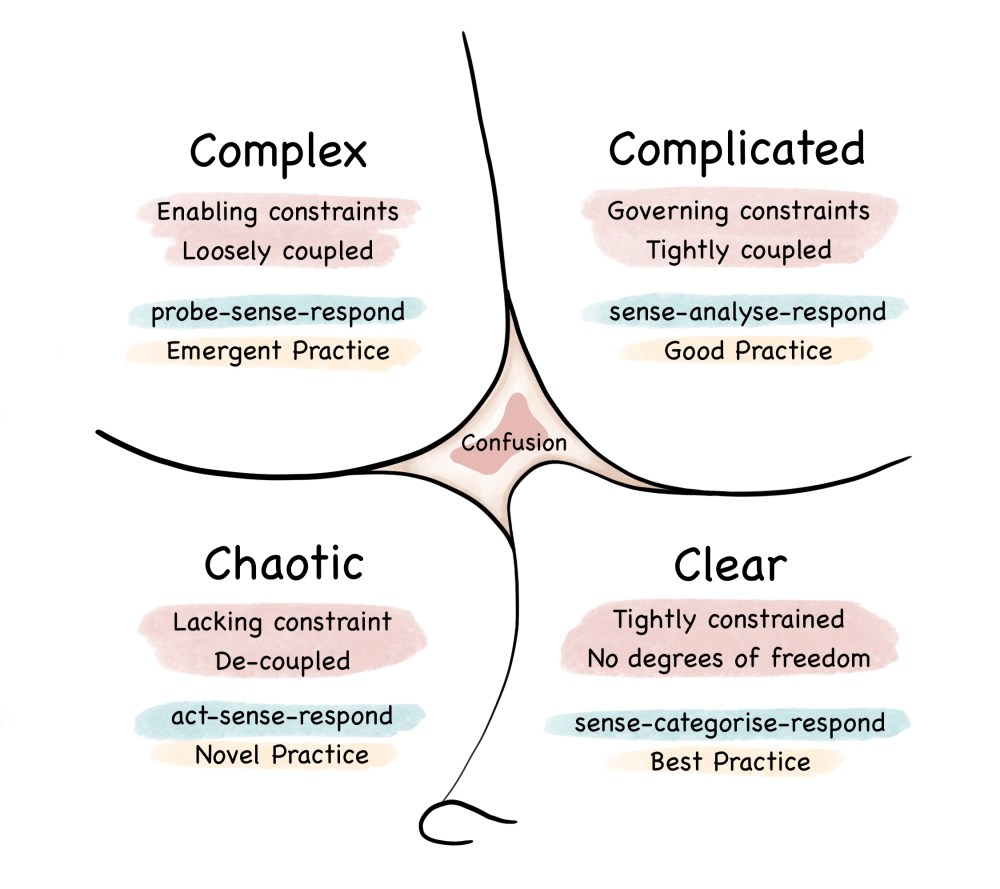Dealing with a complicated problem? Learn this little-known decision framework used by executives, militaries and software development teams.
The Cynefin (pronounced ku-nev-in) Framework is a surprisingly little-known problem solving framework.
But it gives you superpowers in figuring out how to approach problems of any size or complexity.
What’s so great about it is that it helps you quickly categorize a problem, and gives you a formula for how to solve it.
Here is a breakdown of the model and how it applies.
Cynefin is Welsh for “habitat”. The Cynefin Framework was invented by an employee of IBM Global Services, David Snowden to manage Intellectual Capital.
You can read David’s article about Cynefin in the Harvard Business Review here. He’s also written a book on the framework.
It’s broken down into four “Domains”—categories for different types of problems you may encounter, and an approach for how to solve each type of problem.

Domain #1: Clear
When a problem and it’s solution is well-known, it’s part of the “clear” domain.
Instructions, best practices or established processes for addressing these sorts of problems already exist.
Some examples of problems in the Clear domain include:
- Building a paper airplane
- Paying a bill online
- Putting together a piece of Ikea furniture you’ve ordered
Each of these examples are solvable by following set processes or instructions. Expertise isn’t needed.
Here, you solve the problem by establishing the facts, determining if the problem is “Clear”, then following the prescribed formula. The framework calls this “sense, categorize, respond”.
A common mistake is to oversimplify a problem, and label it as “Clear”, when it really falls into one of the below domains.
Domain #2: Complicated
A problem is “Complicated” when it requires expertise in order to solve.
Solving this sort of problem isn’t as clear, and there may be more than one “right answer”. There is where experts come in to properly diagnose and fix the problem based on their experience.
Some examples of Complicated problems include:
- Fixing a car
- Building a piece of furniture from scratch
- Writing a short programming script to perform a few simple functions
Each of these examples have multiple different approaches, and require someone with some know-how or experience to take the right course of action.
Assuming you’re an expert, you solve the problem by establishing the facts, analyzing the problem based on your experience, then proceeding. The framework calls this “sense, analyze, respond”.
Domain #3: Complex
A problem is “Complex” when there isn’t a clear “right answer”. This is often the case when you’re in an environment in a constant state of flux.
Finding any answer in how to solve a Complex problem requires some investigation in it’s own right.
Some examples of Complex problems include:
- Mergers and acquisitions
- Saving endangered species in a rainforest
- Validating and launching a new business
None of these problems have clear right answers and are very context-dependent.
Here, you. solve the problem by experimenting first. After experimenting, evaluate the outcome of the experiment, then proceed. The framework calls this “probe, sense, respond”.
Domain #4: Chaotic
A problem is “Chaotic” when you are facing an emergency situation, and timing is of the essence.
It’s pointless to analyze anything about the problem. You need to act fast.
Some examples of Chaotic problems include:
- Putting out a (literal) fire
- Addressing a flooding basement
- Helping someone who is critically injured
Often, the right course of action in each of these examples are fairly obvious. Putting out a literal fire might involve stomping out the fire, using a fire extinguisher, or evacuating if there is nothing to put the fire out with.
You must act first, then sense where things are still unstable, then respond by bringing the unstable portions out of a state of chaos. The framework calls this “act, sense, respond”.
Next time you face a problem, categorize it, and take these approaches. You’ll find that it gives you a much greater degree of clarity on how to tackle the problem.
- Clear: sense, categorize, respond
- Complicated: sense, analyze, respond
- Complex: probe, sense, respond
- Chaotic: act, sense, respond
